Toilet bowl: how to connect the tank to the water supply and
Not only comfort when visiting the restroom, but also the safety of its operation depends on the correct installation of sanitary appliances in the toilet room. After all, if the water supply to the toilet is carried out incorrectly, this can lead not only to problems with the sink, but also to trouble with neighbors who hardly will not notice the water dripping from the ceiling.
Avoid the above troubles and correctly perform all the work will help the instruction below.
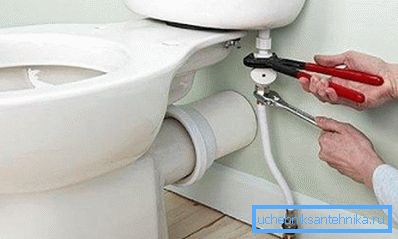
The choice of the toilet and the nuances of its installation
Toilet bowl is an integral element of any city apartment or house. Most people completely in vain do not pay proper attention to the choice of this device. Meanwhile, there are a huge number of models, differing not only in size and color, but also in the shape of the bowl, the location of the outlet, the design of the drain tank and so on.
On the type of toilet depends on how it is installed. After all, if, for example, you purchased a model with a vertical outlet channel, and a sewer pipe is laid in the wall, installation will be impossible, you will have to either modify the engineering network, or buy a new plumbing fixture.
Also before purchase it is necessary to decide how the water supply to the toilet bowl will be carried out.
In order not to experience inconvenience and problems with the operation of the toilet, it is advisable to follow these rules:
- Choose the right toilet. A huge range of these products in modern hardware stores allows you to choose any model based on personal preferences. It is desirable that the device you are buying was not only beautiful, but also easy to install with your own hands. Considerable influence on the choice and the price. As a rule, foreign models of plumbing are quite expensive, but there are domestic options, the cost of which is quite democratic, and the quality is at the proper level.
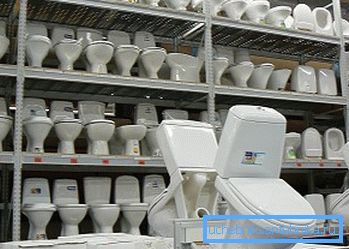
- Buy high-quality accessories, additional equipment and tools. The specific set depends on how the toilet will be fixed: on the studs, cement mortar and so on. In any case, you need to stock up on hoses, gaskets of different diameters, polymer tape to seal the threaded connections, silicone sealant and other trifles.
- Pay particular attention to the preparation of the base during installation.. The floor must be perfectly level so that the installed toilet does not swing from side to side. This not only creates discomfort during its use, but can also cause injury.
- Connect the device securely and firmly with water supply and waste disposal systems.. This is where pre-purchased seals come in handy. Make sure that the dimensions of the gaskets exactly match the diameter of the holes.

Tip! After completing the work, you should pause for sealants for sewer pipes and gels to polymerize. Only after 3-4 hours can a trial run of the cistern be carried out into operation.
Water supply to the tank
Types of hoses used
The connection of the toilet cistern with the plumbing system is, at first glance, a simple procedure. But in carrying out the work, it is necessary to pay attention to some features that to a large extent affect the final result.
Tip! First of all, turn off the water in the plumbing system. To do this, use either a faucet, which stands on a special branch for a toilet bowl, or, in the absence of the latter, a stop valve, which is responsible for the whole apartment.
The next stage is the choice of the type of liner. All existing species and their features are presented in the table.
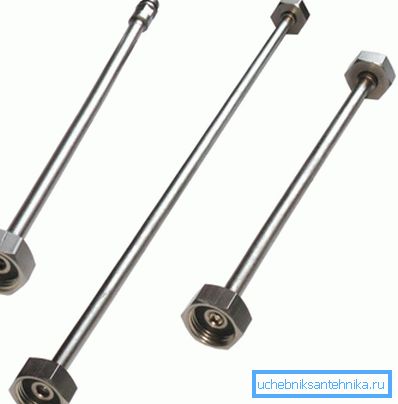
| View | Description |
| Tough | To connect the inlet pipe of the drain tank with the pipe of the plumbing system, pipes made of steel or copper are used. The first is a corrugated pipe, characterized by durability and durability. All the elements in contact with the liquid are made of stainless steel, which eliminates the formation of corrosion. Copper tubes are almost never used due to their high cost. |
| Flexible | For the connection of water to the inlet of the storage tank correspond to hoses made of various materials. Flexible eyeliner to the toilet is no less reliable than steel, but allows you to equip the supply of a complex configuration. The most commonly used rubber tubes are reinforced with metal threads. Buy materials from well-known manufacturers, since cheap imitations can be torn, and the water that flows out can be poured over by neighbors. |

Tip! During installation, make sure that the flexible pipe is connected to the cold water supply system, and not to the hot water supply pipeline.
The location of the inlet nozzles
There are several ways to connect the toilet bowl with plumbing. The specific type depends on the design of the sanitary device itself and on the method of placement of the storage tank. Some cans can be fixed on the toilet itself, others can be hidden on the wall or just hung on it.
And in fact, and in another case, the location of the inlet is extremely important, because sometimes building structures make it impossible to attach the hose.
Consider all the options for the location of the inlets for nozzles:
- With side liner. Such models are most common. Holes for connection equip both on the right and on the left side of the tank to facilitate the installation work as much as possible. Toilets, in most cases, put so that on the sides there is free space for their comfortable use. Consequently, the hose attached to the side of the tank will be convenient to install, and it is easy to close the valve if necessary. Sometimes a sink is placed close to the toilet bowl, which complicates the connection. In this case, you can choose not a rigid pipe, but a flexible hose that takes any convenient form.
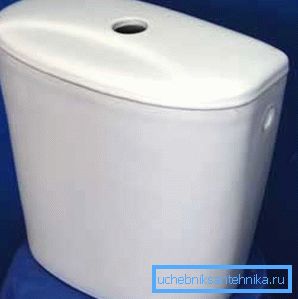
- With back liner. Tanks with rear hose connections are rarely used. After all, the toilets are usually placed so that the back of them almost closely adjacent to the wall of the toilet. That is, access to the pipe and valves, blocking the access of water, will be very difficult. In addition, it is likely that while using the toilet bowl, the hose of the eyeliner will be damaged, and this will lead to the formation of a leak.
- With bottom liner. This method is the most aesthetic, since the hoses, nozzles and shut-off valves are almost invisible and do not bring dissonance into the interior of the restroom. The downside to this solution is the complexity of the installation. Here, you must first install the nozzle and connect it to the supply hose, and only then install the toilet drain capacity on the bowl.
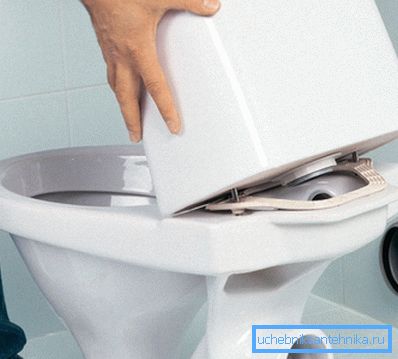
Installation of the supply hose
The process of connecting the toilet to the water supply system in the drain tank is as follows:
- In order to avoid leaks you need to turn off the water in the plumbing system of the apartment or house.
- A purchased flexible hose or a corrugated pipe should be connected to a pre-equipped cold water supply pipe. It is advisable to do this through valves - a tap - which can block the access of water to the toilet without interrupting the work of the entire engineering network.

- All pipe threaded connections must be sealed with a special polymer tape and silicone sealant. Remember that the sealing gel must dry before the water starts up in the equipped supply.
- The branch pipe is installed. As a rule, it is a plastic sleeve, fixed in one of the holes (on the right, left, below or behind) and fixed with the help of special nuts.
- The inlet is connected to the inlet of the socket. It is already equipped with a special gasket to ensure tightness, but for reliability it is better to use plastic sealing tape.
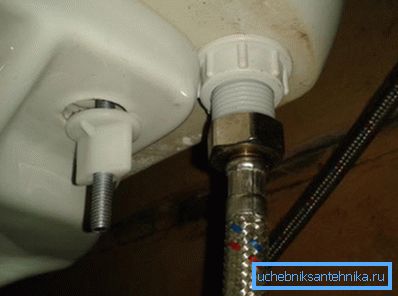
- At the end of the connection, you need to wait 2-3 hours until all sealants are completely hardened, then open the stop valve and try the toilet bowl in action. Check the following joints for tightness:
- between the pipe and the water pipe;
- between the hose and the inlet of the cistern;
- at the junction of the storage tank and the toilet bowl (there is a large rubber sealing ring installed).
Installation of tank drain fittings
In addition to the liner, the mechanism installed there is responsible for the proper functioning of the cistern. Its cost is low, and you will have to pay a considerable amount for installation services. Because this operation is also better to do yourself.
Drain fittings are installed as follows:
- At the outlet of the tank is set to the mechanism. To ensure tightness, there is also used a rubber or silicone gasket. When purchasing fittings, check that the seal is not damaged.
- From the inside, a valve is attached to the inlet pipe, which controls the flow of water to the tank.
- Then the water level is regulated. You need to control the float with a special screw. His position is chosen empirically.

Conclusion
The hose for the water supply to the toilet is a small but very important detail. It is here that there are often leaks that cause big problems. Knowing the procedure for connecting the drain tank to the water supply network, and carefully following all the recommendations, you can be sure of the reliability and durability of the connection.
But it is equally important to properly connect the toilet to the sewer pipe. About our topic you can learn more clearly from the video in this article.